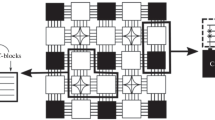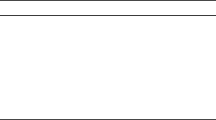Abstract
This work extends to the switch level the verification and testing techniques based upon boolean satisfiability (SAT), so that SAT-based methodologies can be applied to circuits that cannot be well described at the gate level. The main achieved goal was to define a boolean model describing switch-level circuit operations as a SAT problem instance, to be applied to combinational equivalence checking and bridging-fault test generation. Results are provided for a set of combinational CMOS circuits, showing the feasibility of SAT-based verification and testing of switch-level circuits.







Similar content being viewed by others
Notes
Hereafter, we will use the summation symbol to denote the logic disjunction and juxtaposition to denote the logic conjunction.
We use lower case greek letters to denote the clausal formulas to be added to Φ.
References
Acken J (1983) Testing for bridging faults (shorts) in CMOS Circuits. In: Proceedings of design automation conference, pp 717–718
Arumi D, Rodriguez-Montanes R, Figueras J (2008) Experimental characterization of CMOS interconnect open defects. IEEE Trans Comput Aided Des Integr Circ Syst 27(1):123–136
Barzilai Z, Beece D, Huisman L, Iyengar V, Silberman G (1986) SLS a fast switch level simulator for verification and fault coverage analysis. In: Proceedings of design automation conference, pp 164–170
Blaauw D, et al (1987) Automatic generation of behavioral models from switch-level descriptions. In: Proceedings of design automation conference, pp 179–184
Biere At, et al (eds) (2009) Handbook of satisfiability. IOS Press
Brglez F (1985) A fast fault grader: analysis and applications. In: Proceedings of IEEE international test conference, pp 785–794
Bryant R (1984) A switch-level model and simulator for MOS digital systems. IEEE Trans Comput 33:160–177
Bryant R (1987) A survey of switch-level algorithms. IEEE Des Test, 26–40
Bryant R (1991) On the complexity of VLSI implementations and and graph repreentations of boolean functions with application to integer multiplication. IEEE Trans Comput 40:205–213
Bryant R, Schuster M (1985) Performance evaluation of FMOSSIM a concurrent switch-level fault simulator. In: Proceedings of design automation conference, pp 715719.
Carrabina-Bordoll J, Ribas-Xirgo L (1995) Analysis of switch-level faults by symbolic simulation. In: Proceedings of design automation conference, pp 352–357
Drechsler R, et al (2009) Test generation using boolean proof engines. Springer
Drechsler R, et al (2008) On acceleration of SAT-based ATPG for industrial designs. IEEE Trans Comput-Aided Des Integr Circ Syst 27(7):1329–1333
Een N, Sorensson N (2003) An estensible SAT solver. In: SAT
Favalli M, Dalpasso M (2009) How many test vectors we need to detect a bridging fault? J Electron Test Theory Appl 25(1):79–95
Hayes JP (1986) Pseudo boolean logic circuits. IEEE Trans Comput C-35:602–612
Kuehlmann A, Ganai MK, Paruthi V (2001) Circuit-based boolean reasoning. In: Proceedings of design automation conference, pp 232–237
Kundu S (1998) Gatemaker: a transistor to gate level model extractor for simulation, automatic test pattern generation and verification. In: Proceedings of international test conference, pp 372–381
Larrabee T (1992) Test pattern generation using boolean satisfiability. IEEE Trans Comput-Aided Des Integr Circ Syst 11(1):4–15
Lavo D, Larrabee T, Chess B (1996) Beyond the byzantine generals: unexpected behavior and bridging fault diagnosis. In: Proceedings of IEEE international test conference, pp 611–619
Lee K-J, Njinda C, Breuer M (1994) Switest: a switch level test generation system for CMOS combinational circuits. IEEE Trans Comput-Aided Des Integr Circ Syst 13(5):625–636
Lo C, Nham H, Bose A (1987) Algorithms for an advanced fault simulation system in MOTIS. IEEE Trans Comput-Aided Des Integr Circ Syst 6:232–240
Marques-Silva J, Glass T (1999) Combinational equivalence checking using satisfiability and recursive learning. In: Proceedings of design automation and test in Europe, pp 145–149
Nayak D, Venkataraman S, Thadikaran P (2004) RAZOR: a tool for post-silicon scan ATPG pattern debug and its application. In: Proceedings of VLSI test symposium, pp 97–102
Novakovsky S, Shyman S, Hanna Z (2002) High capacity and automatic functional extraction tool for industrial VLSI circuit designs. In: Proceedings of international computer aided design conference, pp 520–525
Orshanky M, Nassif S, Boning D (2008) Design for manufacturability and statistical design: a constructive approach. Springer
Ribas Xirgo L, Carrabina-Bordoll J (1999) Digital MOS circuit partitioning with symbolic modeling. In: Proceedings of design automation and test in Europe, pp 503–508
Sentovich EM, et al (1992) SIS: a system for sequential circuit synthesis. Tech Rep, University of California, Berkeley
Shih H, Abraham J (1985) Transistor-level test generation for physical failure in CMOS circuits. In: Proceedings of design automation conference, pp 825–828
Singh KJ, Subrahmanyam PA (1995) Extracting RTL models from transistor netlists. In: Proceedings of international conference on computer-aided design, pp 11–17
Weste N, Eshragian K (1993) Principles of VLSI design a system perspective. Addison-Wesley, Reading
Wiklund K, Magnusson T, Dahlgren P (2000) Switch-level test generation of competing bridging faults in the presence of feedback. Tech Rep, Department of Computer Engineering, Chalmers University of Technology, pp S-412
Yang Y-S, et al (2006) Extraction error modeling and automated model debugging in high-performance custom designs. IEEE Trans Very Large Scale Integr (VLSI) Syst 14(7):763–776
Zhuang N, Wu H (1992) A new design of the CMOS full adder. IEEE J Solid State Circ 27(5):840–844
Author information
Authors and Affiliations
Corresponding author
Additional information
Responsible Editor: M. Hsiao
Rights and permissions
About this article
Cite this article
Favalli, M., Dalpasso, M. Applications of Boolean Satisfiability to Verification and Testing of Switch-Level Circuits. J Electron Test 30, 41–55 (2014). https://doi.org/10.1007/s10836-014-5433-0
Received:
Accepted:
Published:
Issue Date:
DOI: https://doi.org/10.1007/s10836-014-5433-0




